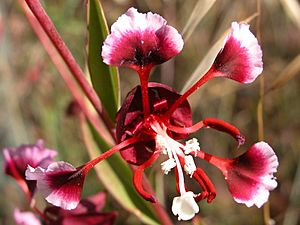Springville clarkia facts for kids
Quick facts for kids Springville clarkia |
|
|---|---|
 |
|
| Conservation status | |
| Scientific classification | |
| Genus: |
Clarkia
|
| Species: |
springvillensis
|
Clarkia springvillensis, also known as the Springville clarkia, is a very special and rare flowering plant. It belongs to the evening primrose family. This plant is found only in a small area of central Tulare County, California. There are fewer than 20 known places where it grows near Springville. Because it is so rare, the United States government has listed it as a threatened species. This means it needs protection to survive.
Contents
Where the Springville Clarkia Lives
This rare plant grows in central Tulare County, California. Some groups of these plants are on private land. However, many others grow on land that is partly protected. These protected areas are managed by groups like the California Department of Fish and Game, the Bureau of Land Management, and the US Forest Service. These lands are found within the Sequoia National Forest.
Why This Plant Is Rare
The Springville clarkia faces several challenges that make it rare. One big problem is non-native plants. These are plants that don't naturally grow there and can take over the space the clarkia needs.
Other threats include road work, animals like livestock eating or stepping on the plants, and new buildings being built. For example, one group of these plants near Springville completely disappeared. This happened when their land was turned into a mobile home park.
What the Springville Clarkia Looks Like
The Springville clarkia is an annual herb. This means it grows from a seed, flowers, produces seeds, and then dies all within one year. It grows straight up and can reach almost 3 feet (1 meter) tall.
Leaves and Stems
Its leaves are shaped like a spear and can be up to 3.5 inches (9 centimeters) long. The plant's stems and leaves are smooth and have a waxy feel. They do not have any hairs.
Flowers
The flowers grow in a cluster. Some flowers are open, while others are still hanging as closed buds. The flower has deep red sepals. These sepals stay connected even as the petals open from one side.
Each petal is shaped like a diamond and sits at the end of a long, thin part called a claw. The petals are a pretty pinkish-lavender color. They also have a purple spot at their base. The flower has 8 stamens, which are the parts that produce pollen. Some stamens have large, red pollen holders (anthers), while others have smaller, paler ones. The stigma, which is the part that receives pollen, sticks out from the center of the flower.
Discovery of the Springville Clarkia
The Clarkia springvillensis was first officially described by a scientist named Frank Charles Vasek. He wrote about it in 1964. His description appeared in a scientific magazine called Madroño. This magazine is published by the California Botanical Society.


